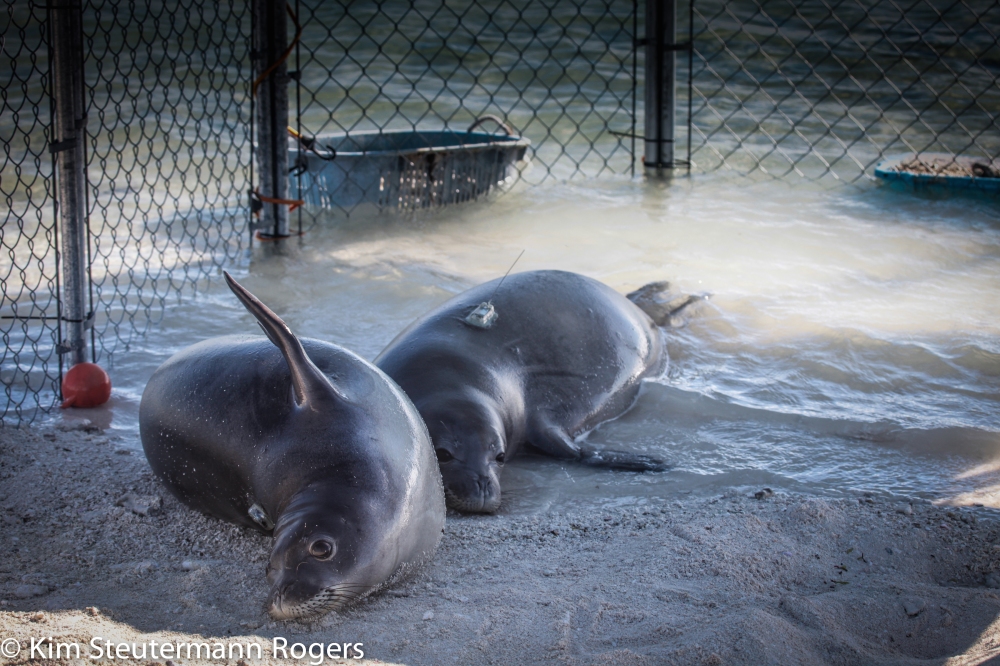Every time we climb down the Jacob’s ladder into a small boat, and our coxswain pulls away from the Oscar Elton Sette, I say, “This is my favorite part of the day.”
I’ve been on the ship for more than two weeks, but nothing beats being this close to the water just after sunrise. So close, I could, if safety protocols allowed, trail my finger in the turquoise blue ocean the way a Laysan albatross often dips its wing and skims a leading flight feather across the surface of the sea.
“My stress level falls every time,” Jessie, our cruise’s Chief Scientist, agreed, wearing a smile you couldn’t wipe off her face.
The Sette sets up in the leeward side of whatever island we’re planning to survey. That means our small boat always heads east into the rising sun, following the path of glare laid down on the water to whatever spit of land we’re destined for the day.
On this day, the reef encircling the atoll was frosted in white, thanks to the remnants of a tropical storm that was pushing swells of the six-foot variety across the outer reef. Rainsqualls smeared across the horizon. When I turned around, I saw a rainbow arcing over the Sette. Hopefully, a good sign for the day.

This was a big day. The one we’d all been waiting for. Ever since that day in May when the Hawaiian Monk Seal Research Program stopped at Pearl and Hermes Reef to set up their summer field camp—and found two early-weaned and starving pups.
And also ever since the two joined our crew on the fantail of the ship as roly-poly eating machines and started pooping—and stinking—up a storm. We take three-hour shifts, keeping an eye on Pearl and Hermes 24 hours a day. For the record, Hermes’ pen once had to be cleaned five times during a couple back-to-back shifts. It was time to get these two off the ship.
The plan was to transfer Pearl and Hermes from the Sette to their namesake atoll, setting up a shore pen with access to sand for sleeping and water for exploring. They would acclimate here for a few days before being given access to the whole of the Pacific Ocean.
Approximately 22 million years ago, a large shield volcano resided where Hawai‘i Island is today. Over millennia, due to the shifting of the earth’s plates, Pearl and Hermes Reef can now be found 168 miles northwest of Lisianski at 27 degrees latitude. Instead of powdery sand, like at Lisianski, the sand at Pearl and Hermes looks like grains of white rice.
The atoll is named after two whaling ships that wrecked on the reef during a storm in 1822. Typical of atolls, in which the original island has all but sunk into the sea while its encircling reef continues to flourish, total land mass pales in comparison to the size of the reef—approximately 80 vs. 194,000 acres. Numerous of those 80 land acres are ephemeral, emerging and subsiding with the ocean’s shifting currents.
Back in August, the hurricane that caused all the field campers (except those at Kure Atoll) to depart breezed through the Northwestern Hawaiian Islands, supposedly sideswiping Pearl and Hermes. We didn’t find much damage. However, the storm’s waves shifted sand around as if it were playing in a child’s sand box, in one case, nearly splitting an islet into two. At the largest island in the atoll, Southeast, a small fishing skiff that had been all but buried in sand was uncovered.
Southeast itself is nearly cut in half by a lagoon that serves as the perfect respite for Hawaiian monk seals. I spotted three adults hauled out and lined up like hash tags across the lagoon and a molting male nestled in a patch of verbesina, a daisy-like flowering invasive plant. A couple juveniles splashed in the lagoon.
This is where we would build a shore pen for Pearl and Hermes, the rehabilitated Hawaiian monk seal weaners, who arrived from the Sette separately in large dog crates the same way we did—by small boat.
Hermes came first. When the door to his kennel was opened, his nose emerged, and he looked around. “Go It’s all yours,” Charles, lead scientist for the Hawaiian Monk Seal Recovery Program, said. Hermes went straight for the water, sticking his head under and emerging with a chunk of coral in his mouth that he promptly flung into the air.
Pearl arrived shortly thereafter. When the door to her kennel was opened, she didn’t hesitate. She went straight for Hermes.
Now, we wait.
In a few days, the door to their shore pen will be opened, and it will be like their second weaning. It’s exciting and scary, at once.
Unlike other monk seal weaners,though, we’ll be able to keep tabs on these two, because of the shiny, new GPS tags on their backs.

I’m loving these reports. Mahalo, Kim and smooth sailing!
LikeLike
Thanks for the well wishes. We need them. Seas are picking up!
LikeLike
I’m really enjoying your posts Kim. It gives me new perspective on the seals on our beach.
LikeLike
This has been an eye-opening and mind-expanding experience!
LikeLike
Imua, Pearl and Hermes!
LikeLike
Indeed!
LikeLike
Blessings to you all and to these pups of the future. Wonderful writing.
LikeLike
Thanks, Dana. It’s fun to write about monk seals!
LikeLike
A very exciting day, even way over here in Oregon. Hope all goes well!
LikeLike
So far; so good, Susan!
LikeLike
Here’s to long and healthy lives, Pearl and Hermes!
LikeLike
Yes!
LikeLike
I’m talking to 4th and 6th graders and passing along the latest on the hospital-bound pups. Thanks for the detailed descriptions that can weave into a story for our very interested keiki! Can’t wait to see how Pearl and Hermes do in the wild. Kathy Brown
LikeLike
Great to hear from you, Kathy. I’m so glad you’re finding these posts useful for education. Love that!
LikeLike